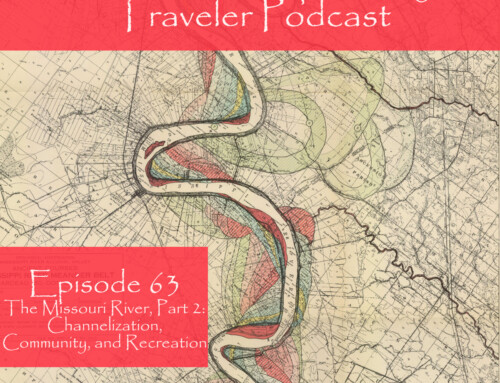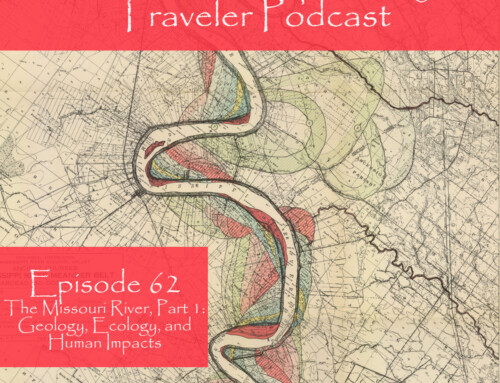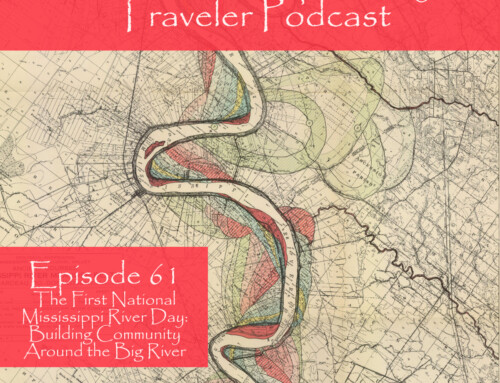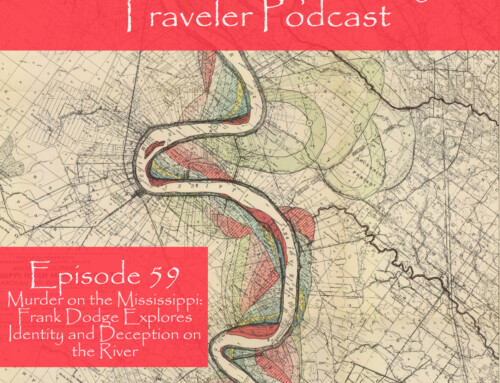In 1849, St. Louisans must have wondered what they had done so wrong to deserve suffering through two terrible tragedies. Steamboats brought cholera to the city, triggering a deadly epidemic that would ultimately kill thousands of people. In the early waves of the epidemic, a steamboat fire on the levee got out of control and quickly spread on land. While only three people died in the fire, the central part of the city was devastated. In this episode of the Mississippi Valley Traveler podcast, I describe how these two events unfolded and the impact they had on the booming city.
Show Notes
Mississippi River Mayhem: Disasters, Tragedy, and Murder on Ol’ Man River by Dean Klinkenberg. Available for pre-order now. Officially releases on September 15.
Support the Show
If you are enjoying the podcast, please consider showing your support by making a one-time contribution or by supporting as a regular contributor through Patreon. Every dollar you contribute makes it possible for me to continue sharing stories about America’s Greatest River.
Transcript
Truly if the ‘wicked are turned into Hell’ at least St. Louis will be strongly represented there.
Welcome to the Mississippi Valley Traveler podcast. I’m Dean Klinkenberg, and I’ve been exploring the deep history and rich culture of the people and places along America’s greatest river, the Mississippi, since 2007. Join me as I go deep into the characters and places along the river, and occasionally wander into other stories from the Midwest and other rivers. Read the episode show notes and get more information on the Mississippi at MississippiValleyTraveler.com. Let’s get going.
Welcome to episode six of the Mississippi Valley Traveler podcast. Today I have two stories about a very tough year for Saint Louis, two disasters both of which could probably have been avoided. Both of these stories are covered more detail in my new book, Mississippi River Mayhem, which is scheduled for release this week, as I record this on September 13, 2022.
The first story I’m going to talk about today is a cholera epidemic, and, yes, I realize that a story about a disease break out may not be what you want to hear right now. I get it. But just imagine the fun I had researching the story back when we were in the middle of the Covid pandemic! Not exactly the most uplifting time, but it was really interesting.
The second story is about the terrible fire of 1849 that devastated the heart of St. Louis in 1849. And just to mess with St. Louisans, the fire broke out in the middle of that cholera epidemic. One lesson: things can always get worse.
One of the things I like about the stories in this episode—not because I take pleasure in tragedy—I’m not THAT person—but the extraordinary sacrifices made by some people. I like knowing that we are capable of making extraordinary efforts to help our community and the people around us. Sure, there are also people who will sink to new lows during tragedies, but we hear enough about them today in our 24/7 news cycle. Today’s stories are about people like you and me under the most difficult of circumstances trying to make sense of what’s going on and to cope.
Thanks to the Patreon supporters, for your on-going support. I appreciate it. And thanks for listening. Now let’s get to the stories.
The Epidemic
Europeans imports to North America included things like honeybees and apples. We’re familiar with those things. Our European ancestors also brought diseases. We’ve heard these stories, diseases like smallpox, measles, influenza, typhoid.
Europeans had some immunity to these diseases after generations of being exposed to them and they passed that immunity to their children. Indigenous people in the Americas did not have immunity, though, and these diseases killed entire communities in some outbreaks.
Other diseases that were introduced to the Americas ended up having a big impact on European and American communities: cholera, malaria, and yellow fever. Many of the worst outbreaks of these diseases were in cities and communities along the Mississippi River. Travel on the big river proved to be an efficient way to spread them around.
Nineteenth century American cities were messy, smelly, and noisy. People were just beginning to understand how sanitation impacted health, but few cities had built sewers or water systems. People dumped waste in the streets. Horses, oxen, pigs roamed freely, and they also left behind large piles of feces in the streets. Much of the human and animal waste flowed right into the wells, ponds, and rivers that residents drank from. When the cholera bacteria found its way to North America in the 1830s, it would thrive in these conditions. Cholera would kill tens of thousands of people and nearly everyone else would be terrified of it.
The first known cases of cholera in North America hit Canada and New York City in 1832. It arrived on ships packed with immigrants arriving from Europe where a cholera pandemic had been raging across the continent from Russia to England. The disease eventually spread to places along rivers. Four thousand people died in New Orleans by the end of the year.
Cholera was not a fun experience for people who got it. You got bouts of watery diarrhea, vomiting, and severe leg cramps.
It could take a couple of days for symptoms to show up, but some infected people got sick within a few hours. Most people, luckily, only experienced mild symptoms. When people died, it was usually from dehydration caused by all that vomiting and diarrhea.
Today, we know best treatment is hydration—drinking plenty of clean water. If you got cholera in nineteenth century, though, you were treated by bloodletting, purging, or opium. One drug treatment of choice was Perry Davis’ Pain Killer, a powerful mix of whiskey, opium, and capsicum. It didn’t cure cholera, but at least you didn’t feel much at all. Doctors also sometimes prescribed a drug called calomel, a powder that consists of chlorine and mercury. If cholera didn’t kill you, the cure might.
People didn’t really understand how cholera was transmitted. People often blamed miasmas—basically air fouled by rotting organic matter. It’s an old idea, going back at least to the Greek physician Hippocrates, who proposed the idea in the 2,400 years ago.
It was also common for some people to blame disease outbreaks on immorality. In 1835, a religious newspaper proclaimed:
“We regard cholera as the judgment of God upon a sinful nation, an intemperate, ungrateful Sabbath-breaking nation. . .a nation which has robbed and spoiled the Indian and withheld that which is just and right from the enslaved African. Cholera will go where it is sent. Best advice: Be ready for death. Death stands at your door. Repent of your sins.”
Cholera came and went over the next couple of decades, then came back big in 1849. St. Louis was one of the worst hit cities. At the time, St. Louis had 77,000 residents and was growing fast. Chouteau’s Pond, a man-made lake, I think… not far from today’s Union Station, was a respite for many St. Louisans, a place to go to escape the summer heat and humidity. Decades of factory waste and sewage runoff turned it into a cesspool primed to fuel an epidemic.
In January 1849, the first cases of cholera showed up in riverboat passengers. The city downplayed it and newspapers generally didn’t report on it. They didn’t want to panic people. Cases remained a trickle until spring, but in the second week of May, 181 died.
Religious leaders prayed for an end to the immorality they believed caused it; not everyone bought the idea: One St. Louisan wrote to a relative: “Truly if the ‘wicked are turned into Hell’ at least St. Louis will be strongly represented there.”
A major fire on May 17 slowed the spread for a bit, which I’ll talk about in a minute.
People fled the city, including most of the city council. Council members later came back just long enough to transfer power to an ad hoc group of citizens who had stuck around. They formed the Committee of Public Health to manage the crisis. The new group aggressively attacked the disease, and sanitation practices were a primary target.
The committee set up temporary hospitals for cholera victims, and assigned doctors and nurses to them. They hired the city’s first employee to provide sanitation services. His entire job was to collect garbage and carry it to locations where it wouldn’t pose a threat to public health.
The committee ordered regular purification fires, a common approach at the time to counter those miasmas that were blamed for spreading disease. To purify the air of infectious agents, each night at eight, barrels filled with coal, sulfur, tar, and even wood were set on fire. The streets filled with dense smoke meant to suffocate the bad vapors that they assumed were making people sick.
While health officials didn’t fully understand the role of fouled drinking water in transmitting the disease, they suspected that there was a connection. A network of inspectors scoured the city to drain pools of standing water. The city opened its water hydrants to supply drinking water from its new reservoirs to its poorer citizens.
Still, the epidemic raged on. Despair settled over the city, and not just because of those purification fires. Eliza Keesacker Howard wrote to her sister:
“It is indescribable, nothing but death, you may see a person well and hearty and the next day hear of their death, everyday is dull and gloomy no one goes to church, no one to the stores, no one in the streets, but funerals passing all the time.”
Funerals ran nearly nonstop.
“The streets are the almost constant scene of funeral trains,” one resident wrote, “while the long solemn tolling of funeral bells, announcing that the destroyer is still doing his fatal works, altogether has imparted a feeling of gloom among the citizens.”
The constant tolling of church bells announcing yet another funeral became so overwhelming that city officials asked churches to suspend the practice during the epidemic.
Gold prospectors heading for California were among the victims. So many died that one paper wrote that the city’s riverbanks were covered with graves.
On some days, as many as one-third of the dead were children under six years old. Others lost both parents. There were no social services at the time. Orphaned children were sometimes taken in by religious organizations. The mayor also had the authority to place orphans with new families, an option that Mayor Barry sometimes exercised.
I sometimes wonder about families who are researching their genealogy, if they know that an ancestor of theirs may have been raised by an adoptive family because of they lost their parents to disease.
As the epidemic raged on, the city set up a quarantine station on the river. Every steamboat had to stop. City inspectors boarded every boat and removed any passengers who looked sick. Those passengers were required to stay at the quarantine station until they recovered, or died.
Deaths peaked in mid-July. City life virtually ceased. Steamboats stopped at St. Louis but couldn’t unload their cargo. By August, deaths were falling rapidly finally. The official death toll was 4,547 but it’s likely that it was more like 8,000, or about 10% of the city’s population. Imagine that. If 10% of St. Louis’s population died today, that would be around 300,000 people.
In 1851, St. Louis drained Chouteau’s Pond. In England, John Snow, through careful observation, figured out the connection between contaminated water and the spread of the cholera. Cities began building new sanitation systems, but it took a while. By the end of the 19th century, cholera was no longer a problem in the US.
Still, up to four million people every year suffer with cholera, and it kills tens of thousands in parts of the world where even today clean water is a luxury.
If you’re enjoying the show, share that love with other people. Leave a review on iTunes or your preferred podcast app. Each review makes a difference and helps other fans of the Mississippi River and the Midwest find this show.
The Fire
We might think that we’ve had it rough lately, but in 1849 St. Louisans must have wondered who had cursed their city. Cholera wasn’t the only cause of suffering.
The evening of May 17 was a pleasantly cool spring evening, the evening sky bright and clear with a light breeze from the northeast. The talk of the town was probably the ongoing cholera epidemic, which everyone was worried about.
In a split second, everyone’s attention shifted. A brilliant light appeared over the levee, followed by the vigorous ringing of steamboat bells.
The steamer White Cloud was on fire. A night watchman had discovered the fire and rang the alarm. The city’s volunteer fire fighters rushed to the scene.
They hooked up a hose to one of the city’s fire hydrants and dragged it on board the boat just south of the White Cloud, the Edward Bates. They had a good vantage point there to direct water from their hose to put out the fire. It was too late, though, so they cut the White Cloud loose to drift away from the other boats.
Unfortunately, that plan didn’t go so well. As the White Cloud slipped away from the levee, fire spread onto the Edward Bates. What happened next isn’t clear. Some witnesses claimed that the firemen and crew cut the Edward Bates loose, while others thought that the fire burned through the mooring ropes. Regardless, the Edward Bates drifted away from the levee, too. As the current carried the boat downriver, it bumped into other boats on the levee and set them on fire—first the Belle Isle and then the Julia, eventually setting at least nineteen more boats ablaze before it settled on a sandbar at Duncan’s Island.
The riverfront was lined with tinder for a fire. Packages of hemp and stacks of lumber burned first, which ignited barrels of lard and bacon. The fire quickly intensified and spread to the warehouses and offices along the levee. Wood frames steadied the brick buildings, and all that wood added still more fuel to the fire. The entire riverfront was engulfed in a wall of fire, with smoke so thick that it became increasingly hard to see a person a few paces away.
More fire fighters were called in as those on the riverfront were forced to pull back. A thousand people were soon involved in fighting the fire, enough to keep it from spreading further north but the fire had managed to spread to the central riverfront when the wind blew coals in that direction. Fire fighters rallied to save the South Market building—arguably the city’s most important building as the city’s most important records were kept there—and a 15-year old church we now know as the Old Cathedral.
Panic took over the rest of the city. Frances Sublette recalled:
“… never did I see anything so awful in my life. The flames seemed as if they would come over Mother’s house and coals of fire larger than both of my hands fell over all the yard and the house… I never felt so much alarmed in my life.”
People tried to hire wagons to move their possessions to a safer place but many of the wagons were already busy carrying the bodies of cholera victims. Wagon drivers charged crisis prices and looters helped themselves to the items piling up in the streets.
People were increasingly fearful. It didn’t help when a loud boom echoed around the city. The steamer Martha, loaded with gunpowder, had caught fire and exploded. The shock waves lifted fire fighters into the air and threw them back.
The fire fighters came up with a last-ditch plan. They proposed creating a fire break by destroying a row of buildings on the edge of the fire. Volunteers hauled barrels of gunpowder from the local arsenal to the proposed break line.
Six buildings had to be blown up. Fire fighters had no way to control the timing of the explosions, though. Each fuse had to be lit individually, then whoever lit it had to run the hell out. One by one, the buildings went down. Thomas Targee, one of the volunteers, carried kegs into three of those buildings. As he carried gunpowder into last building—the home of the Phillips music store—one of his fellow fire fighters thought Targee looked “… smoke-begrimed and haggard.”
As Targee entered that building, a keg exploded. He never had a chance. Two other men in a nearby building, lawyers Wells Colton and Russell Prentiss, were badly burned and died a few days later. Targee’s remains were scattered around the immediate area; a portion of one of his legs landed next to a horse. The fire break seemed to have helped though, that and the non-stop efforts of the volunteers. By seven in the morning, the fire was mostly out.
The commercial heart of the city was devastated. Hulls of burned-out steamers lined the riverfront. One reporter wrote:
“Steamers which were to be seen at any hour thronging at the wharf, from North to South, are now visible only in black and rotten timbers, thrusting their jagged ends a few feet above the waters edge, as if in mockery of mans ingenious handi-work, which should be so defaced in a few minutes.”
Over four hundred buildings were destroyed, including the offices of three English-language newspapers and the telegraph office. Nearly three hundred businesses were ruined, including two-thirds of the wholesale dry goods merchants and half of the grocery stores.
Some people initially suspected that the White Cloud had been set afire intentionally, but no evidence of arson ever surfaced. A fire had, after all, broken out weeks earlier on the boat and in nearly the same spot.
The city rebuilt, of course, and passed new building regulations aimed at preventing future fires. The city also upgraded its water and sewage systems. And less than a decade after the fire, St. Louis created one of the first municipal fire departments in the United States.
Remarkably, just three people died in the fire, including Targee. His remains were faithfully collected and placed in a casket, then taken to Christ Church, where he had served as choir director. Bishop Cicero Stephens Hawks conducted the funeral. Because of the on-going cholera epidemic, only a few people could attend. After the service, he was buried in an unmarked grave at Christ Church Cemetery. His bravery was not forgotten, however. To this day, firefighters revere him for the bravery and sacrifice he made to protect his fellow St. Louisans.
As I mentioned these stories and others are covered in my new book Mississippi River Mayhem, which is now available for pre-order and very soon for actual delivery to your home or your ereader. Find it in the all the usual market places: Amazon, Apple books, independent book stores; wherever you like to purchase books you should be able to find a copy. Thanks so much
And now it’s time for the Mississippi Minute. I have been obsessed with bakeries lately. I was had
a chance to get out of town a couple of weeks ago and the first place where I stopped Krumpets in Fulton, Illinois, where I enjoyed a Krumpets bar. I also like to stop at Sweetheart Bakery across the river in Clinton, Iowa for a blarney.
Hannibal’s Java Jive makes some tasty cookies and other treats. The Galena Bakehouse in Galena, Illinois, offers tempting sweets from around the world, along with some savory empanadas and Argentine cheesy biscuits. They are so good!
I can’t seem to get to La Crosse, Wisconsin, when Meringue is open, but look forward to making hard decisions about which gourmet pastries I want to try. Alton’s Duke Bakery has been pleasing folks with fruit tarts and cream horns since 1951.
What are your favorite local bakeries? One of the things that I like about these places is that they are almost always owned by local families, so I know that—as I’ve said a hundred times—I know that most of the money I spend there will stay in the local community and help folks there. So what are your favorite bakeries along the Mississippi? Where should I go the next time I’m on the road? And do they make something special, something unique that I should try? Leave a comment in the show notes or drop me a note at MississippiValleyTraveler.com.
If you enjoyed this episode, subscribe to the series on your favorite podcast app, so you don’t miss out on future episodes. I offer the podcast for free, but when you support the show with a few bucks through Patreon, you help keep the program going. Just go to patreon.com/DeanKlinkenberg. If you want to know more about the Mississippi River, check out my books. I write the Mississippi Valley Traveler guide books for people who want to get to know the Mississippi better. I also write the Frank Dodge mystery series that is set in places along the river. Find them wherever books are sold. The Mississippi Valley Traveler podcast is written and produced by me. Dean Klinkenberg. Original music by Noah Fence. See you next time.




